Introduction
This article provides information about using a Dell PowerEdge Server 14th generation.
How do I connect to the iDRAC?
In the order completion mail, there are two IP addresses; one of them for the server itself and the other one for the iDRAC. There are also two logins: one for the server itself, and a second one, below that, for the iDRAC. (They are separate logins).
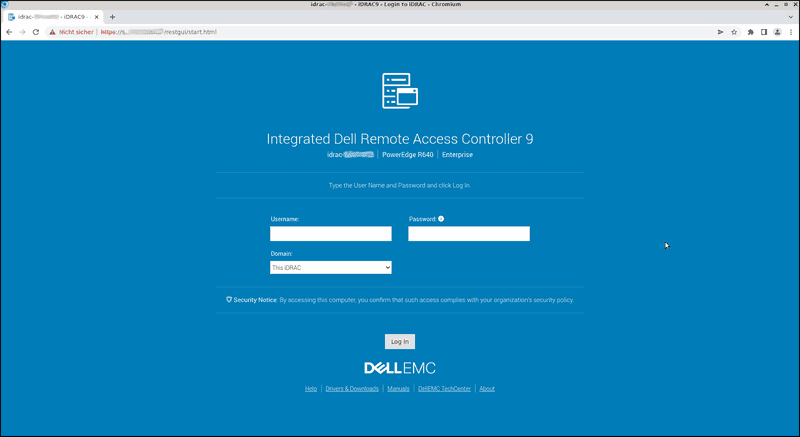
Just enter the iDRAC IP into the address bar of your browser and confirm any possible security warnings. After that, you will see a web interface and you can log on with the iDRAC login information. At this point, you can use the KVM function, turn the server on and off, mount an ISO image for an installation, and diagnose hardware problems.
How do I change the iDRAC password?
First, log into iDRAC and go to the menu iDRAC Settings and select Users. On the page that appears, expand the menu for Local Users.
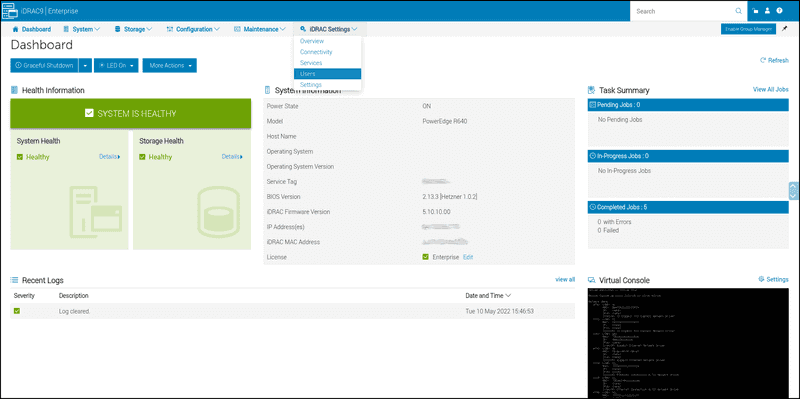
Now click on the user whose password you want to change (e.g. root) and then on the Edit button.
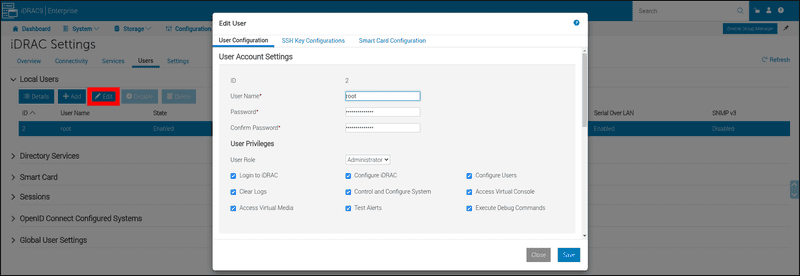
In the pop-up window that now appears, you can already change the password in the correct fields and then apply it by clicking on Save.
What is the KVM function and how do I use it?
The KVM function, more specifically the KVM over IP function, allows you to use the server over a network just as if you were directly in front of the machine with a screen, a keyboard, and a mouse directly attached. When you log onto the iDRAC, you see a preview of the current video output of the server on the bottom right third of the website.
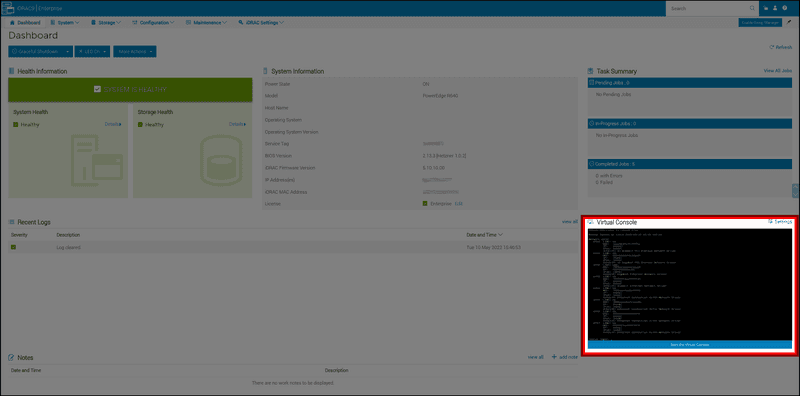
If you click on Launch Virtual Console below the preview and confirm the requests for pop-up windows for the iDRAC address, a new window opens first. In this window, you must add an exception for the SSL certificate. You will then be connected live and can operate the server just like any other computer. For special functions such as a reboot or to send certain key combinations (e.g. CTRL-ALT-DEL), use the menu Console Controls in this KVM window.
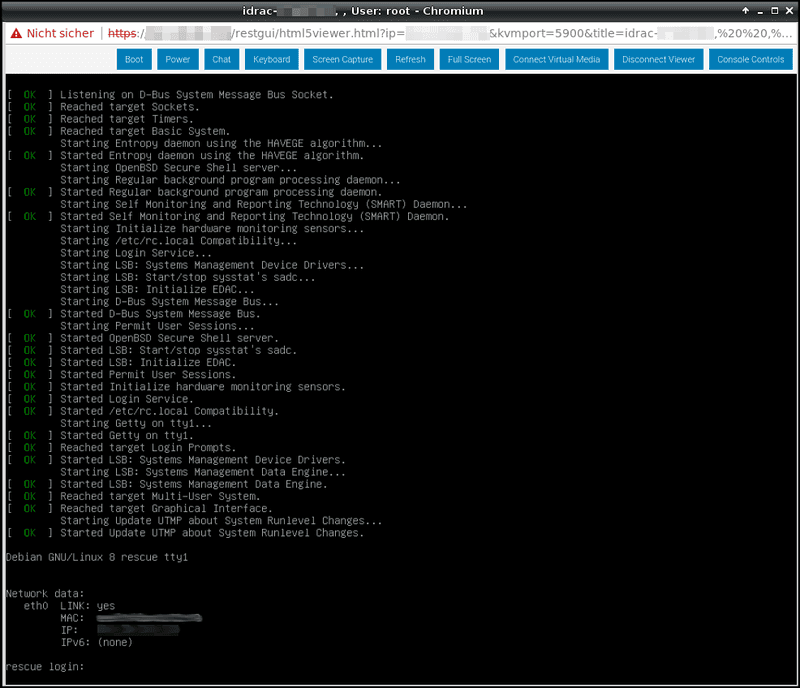
How do I configure the RAID controller?
The RAID controller is only able to use SSD drives, so NVMe drives will be not shown here
First, log in to the iDRAC and select Overview in the upper menu under Storage.

Within the next window click on Virtual Discs

When you click on the Create Virtual Disk button, you will see two options:
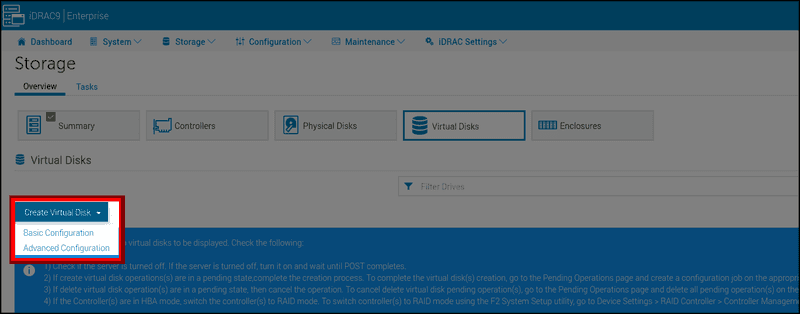
| Option | Short description |
|---|---|
| Basic | Quick creation of RAID layouts |
| Advanced | Ability to change read/write policies or to make other adjustments |
In this example, we used a system with two SSD drives, so we were only able to create RAID 0 or RAID 1. If you have installed more SSD drives, you can also create RAID 5, RAID 6, RAID 10, RAID 50 or RAID 60.
Basic RAID configuration
| Option | Short description | Changes needed |
|---|---|---|
| Name | You will be able to set a volume label | optional |
| Controller | Hetzner currently does not offer servers with two controllers | No |
| Layout | Set the correct RAID layout | Yes |
All other parts here will be just for information and cannot be adjusted.
The drives will be selected upcounting the slot numbers as they are installed into the server
Example RAID-0
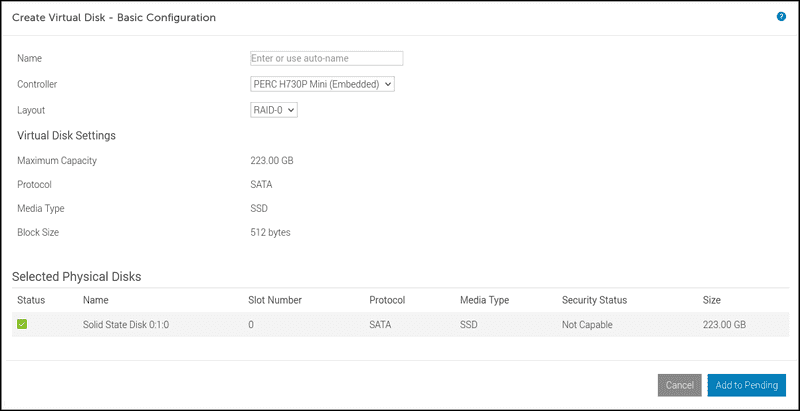
Example RAID-1
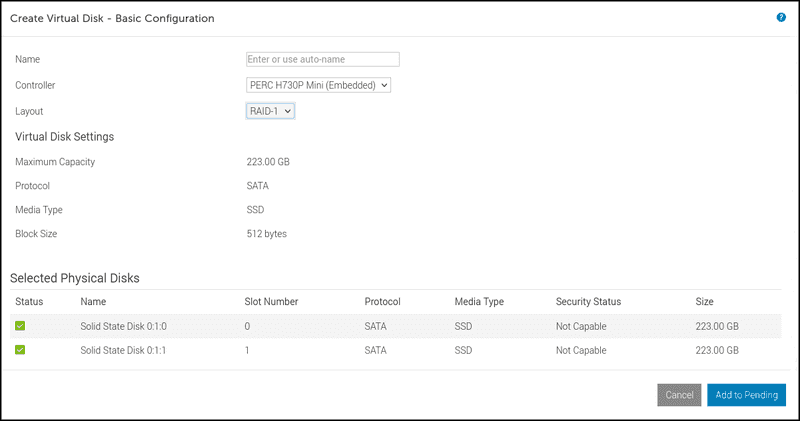
After all settings are set as needed click Add to Pending at the bottom right and the next part will be available.
Again at the bottom you will have the following options:

| Option | Short description |
|---|---|
| Apply Later | You need to create more virtual drives and you want to process the jobs later. Later, the jobs are processed when you click on "Apply now". |
| Apply now | When everything is done, perform it immediately |
| At Next Reboot | When the server performs a full power cycle, the RAID will be created |
| At Scheduled Time | Set an appointment when the job will be created. (The server does not reboot automatically for most selections) |
| Discard All Pending | All changes will be discarded |
Advanced RAID configuration
Step 1
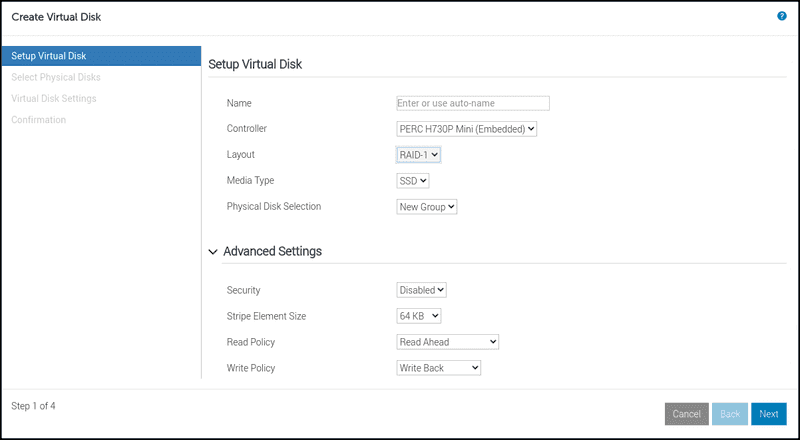
| Option | Short description | Changes needed |
|---|---|---|
| Name | You will be able to set a volume label | optional |
| Controller | Hetzner currently does not offer servers with two controllers | No |
| Layout | Set the correct RAID layout | Yes |
| Media Type | Hetzner currently does not offer HDD or SAS drives for this server type | No |
| Physical Disk Selection | Select the physical disk group | No |
| ---------- | --------------------------------------- | --- |
| Security | Enable or disable security for virtual disk encryption | Optional |
| Stripe Element Size | Select the stripe element size. The stripe element size is the amount of disk space a stripe consumes on each physical disk | Optional |
| Read Policy | Select either No Read Ahead, Read Ahead or Adaptive Read Ahead |
Optional |
| Write Policy | Select either Write Through, Write Back or Force Write Back (This kind of server from Hetzner already has a pre-installed BBU.) |
Optional |
| Disk Cache Policy | Select either Enabled, Disabled or Default (This is enabled since we do not offer SAS drives for this server type.) |
Optional |
Click on Next in the bottom right corner.
Step 2
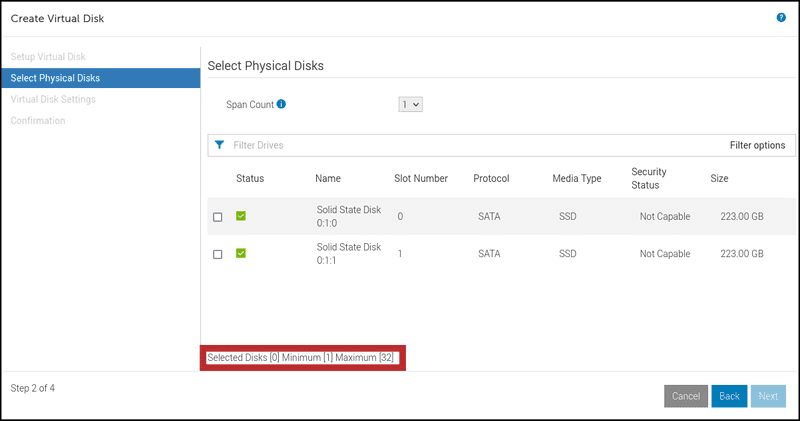
Select the drives, which should be used in the previous selected virtual RAID. The Next button will be only accessible, when the statements, which are marked red in the picture above, will be fulfilled.
Step 3
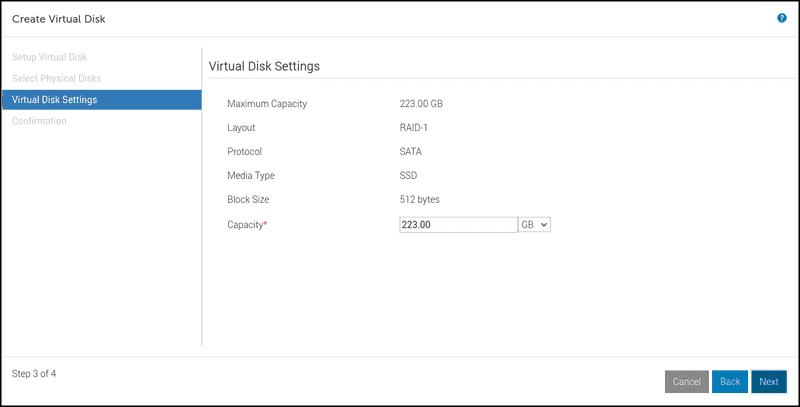
Here you will be able to adjust the size of the virtual disc. By default the size is set to the maximum configurable value.
Step 4
Here you will be notified about all performed changes. If the settings are correct, click on Add to Pending at the bottom right, and it will show the next step.
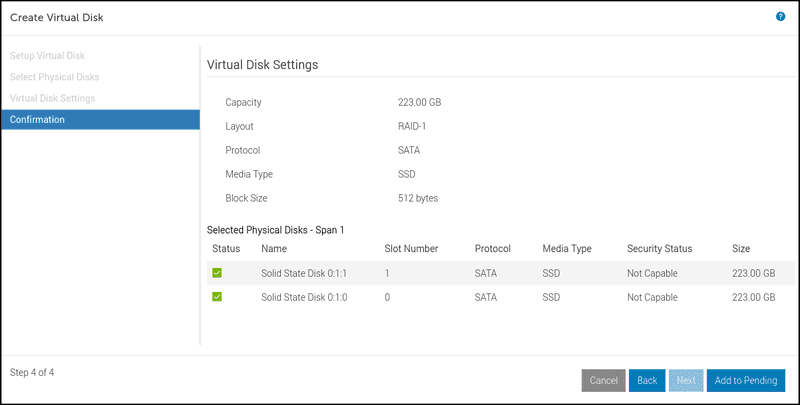
Once again at the bottom you will have the following options:

| Option | Short description |
|---|---|
| Apply Later | You need to create more virtual drives and you want to process the jobs later. Later, the jobs are processed when you click on "Apply now". |
| Apply Now | When everything is done, perform it immediately |
| At Next Reboot | When the server performs a full power cycle, the RAID will be created |
| At Scheduled Time | Set an appointment when the job will be created. (The server does not reboot automatically for most selections) |
| Discard All Pending | All changes will be discarded |
You can now monitor the status of the process in the Job Queue. To do this, click on Maintenance in the top menu and then on Job Queue.
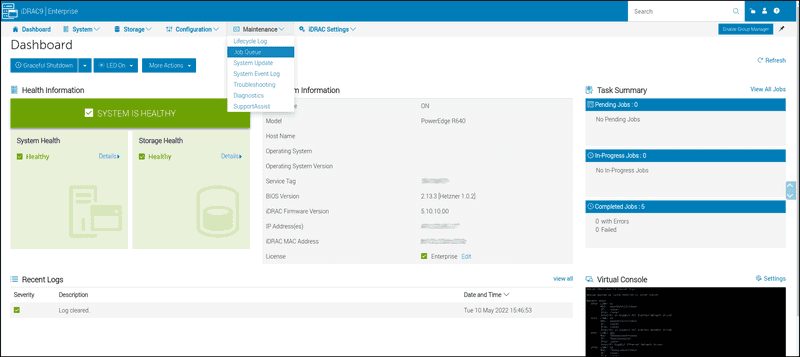
If the process reaches the status Completed, the logical drive should the be visible in the operating system and should be visible in the overview under the menu item Storage -> Overview -> Virtual Disks.

How do I mount an ISO image?
To do this, select the option Connect Virtual Media in the KVM window. Another window will appear in which you can directly select local drives or stream ISO images (CD/DVDs) to the server. If you have chosen one of the options and have selected a device/ISO, click on the corresponding Map Device button and finally on Close. The local drive/ISO should now appear in the operating system/boot menu.
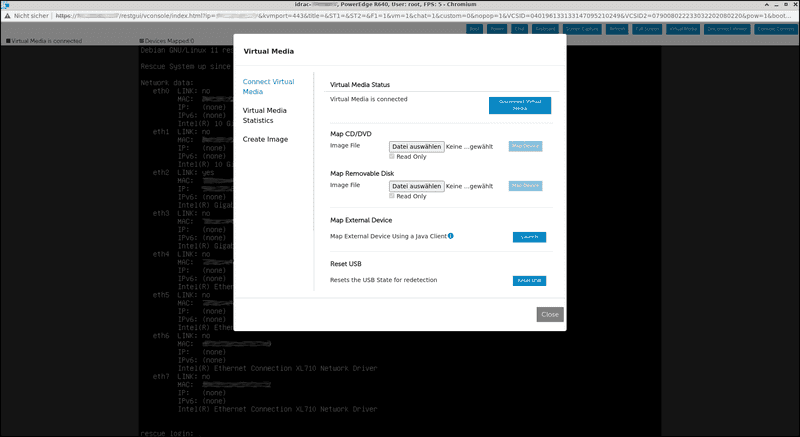
If you restart the server now, you can boot from the image just as you could from any other drive. To do so, please press F11 to go to a boot menu when you see the message to press F11. An even easier way to boot from the image is to select the entry Virtual CD/DVD/ISO in the menu Next Boot on the KVM window.
How do I mount operating system images from the Hetzner Mirror?
To help our clients install an operating system on the server manually, we provide images of certain operating systems.
You can find the images we offer on two of our mirrors:
- http://download.hetzner.com/ You can access this from anywhere, and it requires a username and password to login. You can find these details at the end of your server activation email (the email in which we at Hetzner Online sent you the login details for the server itself).
- http://mirror.hetzner.com/ You can only access this from the Hetzner network, and it does not require a password.
The following examples use the internal mirror, though there is also a link to the external mirror below. You can use this link to the external mirror to check the exact file names of the operating system images.
Windows
You can see the Windows images we have under http://download.hetzner.com/bootimages/windows/.
These Windows images are straight from Microsoft and don't include any changes from us. They do not come with a license. You can use them to install a clean Windows OS on the server, which you can activate with your own license key.
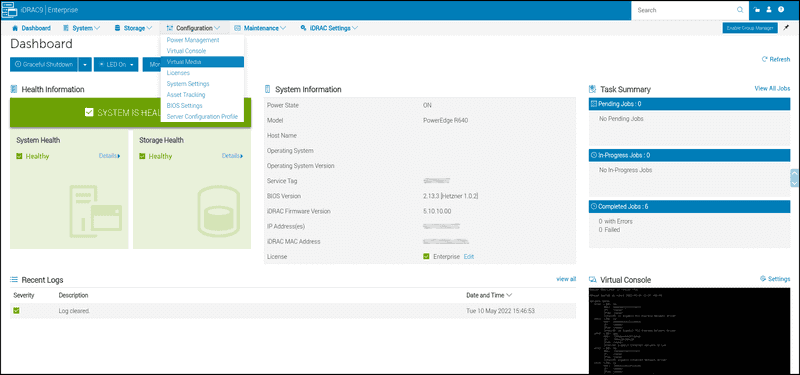
- You can copy the Image File Path directly from our mirror.
- Example:
https://mirror.hetzner.com/bootimages/windows/SW_DVD9_Win_Server_STD_CORE_2022__64Bit_English_DC_STD_MLF_X22-74290.ISO
- Example:
- You can leave the User Name and Password fields blank: you don't need them.
- The iDRAC should now display the value
ConnectedunderConnection Status ... - Now you can set the next boot drive in the KVM window to
virtual CD/DVD/ISO. Or, you can also select the corresponding entry via the boot menu (F11) on the BIOS POST screen.
OS Deployment via the LCC (Lifecycle Controller)
Your DELL Server has an OS Deployment function that is integrated into your server's lifecycle controller. This function provides the necessary drivers for the operating system and guides you with graphical wizards in creating a RAID array if there is no RAID alreadz on your server.
DELL only supports certified operating systems via this function. These may vary from model to model. For an overview of the operating systems for your rented product, please visit the correct DELL website.
- R640 (DX152/DX292): https://www.dell.com/support/home/en-us/drivers/supportedos/poweredge-r640
- R6415 (DX180): https://www.dell.com/support/home/en-us/drivers/supportedos/poweredge-r6415
- R6515 (DX181): https://www.dell.com/support/home/en-us/drivers/supportedos/poweredge-r6515
If you would like to use the OS Deployment function, you must first choose an image from our mirror. As soon as you have chosen the image, you need to restart your server and boot it into the LCC by pressing F10 in the BIOS POST. The following example shows how to use the OS Deployment function with Windows Server 2016.

- When the server is booted up into the LCC, click on
OS Deploymentin the menu on the left side, and then onDeploy OS.
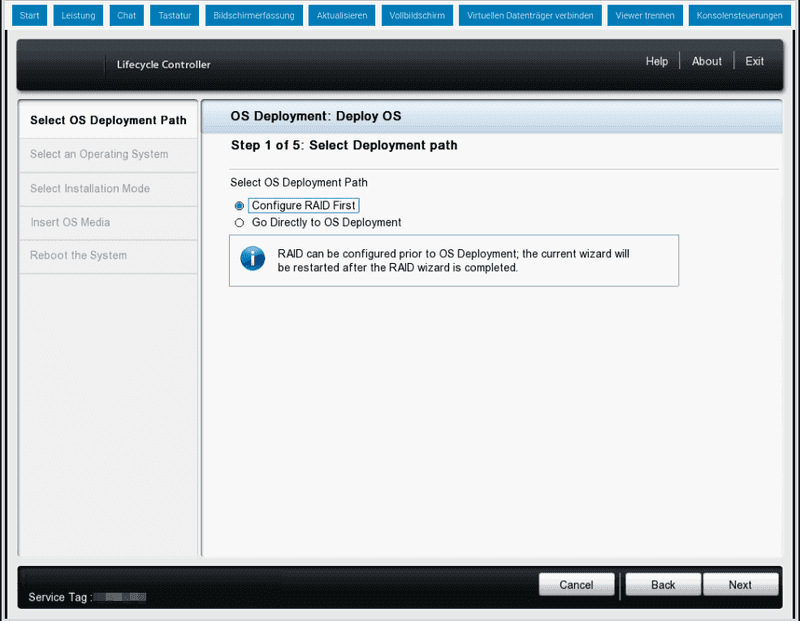
- If you have not yet configured a RAID, you can now configure it by using this wizard. If a RAID already exists on your server, please select
Go Directly to OS Deployment.

- In the next step, select whether you want to install the operating system in BIOS or UEFI boot mode. Then select the operating system you want to install from the dropdown menu.
- If you choose the UEFI mode, you can also select whether you want to use
Secure Bootor not. - Now click on
Next, and the server will collect the drivers required for installation.

- In the third step, select
Manual Installand click onNext. Then, the DELL server will validate the operating system image.
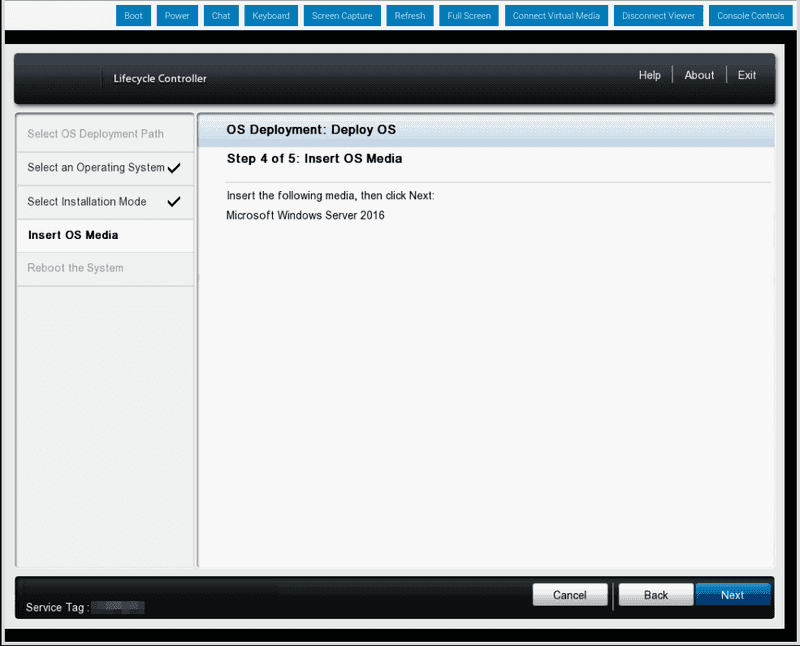
- In the fourth step, simply click on
Nextbecause the image was previously integrated via the iDRAC.

- In the fifth and last step, you will see an overview with the selected settings. Click
Finishif the settings are correct. Then the server will reboot and will start the Windows setup.
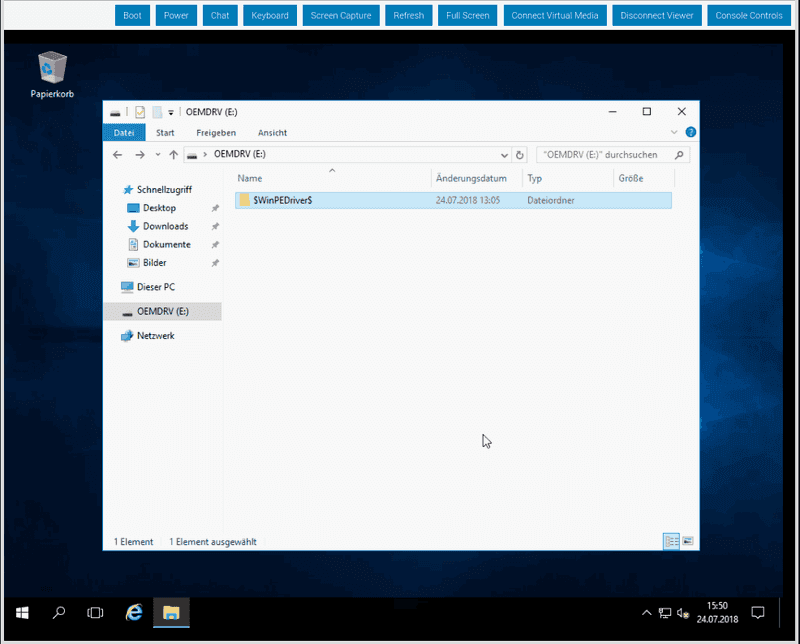
If drivers are missing after the operating system installation, you have a virtual drive where drivers are available for the operating system. This drive is automatically named OEMDRV by the server.